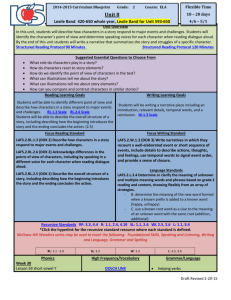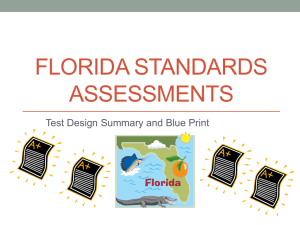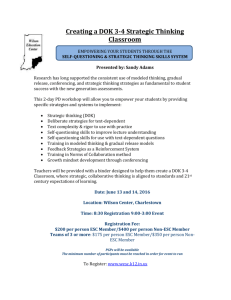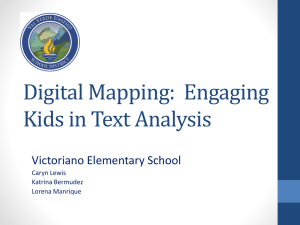2014-2015 Curriculum Blueprint Grade: First Course: ELA District
advertisement
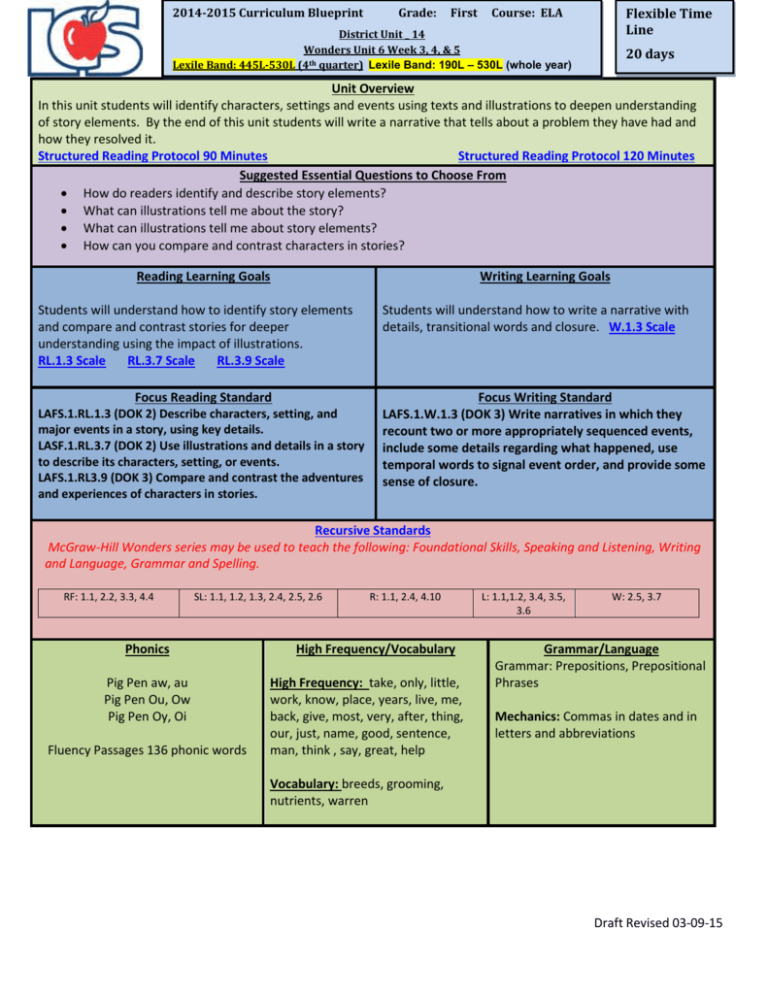
2014-2015 Curriculum Blueprint Grade: First Flexible Time Line Course: ELA District Unit _ 14 Wonders Unit 6 Week 3, 4, & 5 Lexile Band: 445L-530L (4th quarter) Lexile Band: 190L – 530L (whole year) 20 days Unit Overview In this unit students will identify characters, settings and events using texts and illustrations to deepen understanding of story elements. By the end of this unit students will write a narrative that tells about a problem they have had and how they resolved it. Structured Reading Protocol 90 Minutes Structured Reading Protocol 120 Minutes Suggested Essential Questions to Choose From How do readers identify and describe story elements? What can illustrations tell me about the story? What can illustrations tell me about story elements? How can you compare and contrast characters in stories? Reading Learning Goals Writing Learning Goals Students will understand how to identify story elements and compare and contrast stories for deeper understanding using the impact of illustrations. RL.1.3 Scale RL.3.7 Scale RL.3.9 Scale Students will understand how to write a narrative with details, transitional words and closure. W.1.3 Scale Focus Reading Standard LAFS.1.RL.1.3 (DOK 2) Describe characters, setting, and major events in a story, using key details. LASF.1.RL.3.7 (DOK 2) Use illustrations and details in a story to describe its characters, setting, or events. LAFS.1.RL3.9 (DOK 3) Compare and contrast the adventures and experiences of characters in stories. Focus Writing Standard LAFS.1.W.1.3 (DOK 3) Write narratives in which they recount two or more appropriately sequenced events, include some details regarding what happened, use temporal words to signal event order, and provide some sense of closure. Recursive Standards McGraw-Hill Wonders series may be used to teach the following: Foundational Skills, Speaking and Listening, Writing and Language, Grammar and Spelling. RF: 1.1, 2.2, 3.3, 4.4 SL: 1.1, 1.2, 1.3, 2.4, 2.5, 2.6 Phonics Pig Pen aw, au Pig Pen Ou, Ow Pig Pen Oy, Oi Fluency Passages 136 phonic words R: 1.1, 2.4, 4.10 High Frequency/Vocabulary High Frequency: take, only, little, work, know, place, years, live, me, back, give, most, very, after, thing, our, just, name, good, sentence, man, think , say, great, help L: 1.1,1.2, 3.4, 3.5, 3.6 W: 2.5, 3.7 Grammar/Language Grammar: Prepositions, Prepositional Phrases Mechanics: Commas in dates and in letters and abbreviations Vocabulary: breeds, grooming, nutrients, warren Draft Revised 03-09-15 Deconstructed Reading Standards LAFS.1.RL.1.3 (DOK 2) Describe characters, setting, and major events in a story, using key details. Define character. Define setting. Define major events. Define key details. Identify characters using key details. Identify setting using key details. Identify major events using key details. Describe characters using key details, discern which details are important. Describe setting using key details, discern which details are important. Describe major events using key details, discern which details are important. Orally demonstrate understanding of a central message, meaning or lesson. K: With prompting and support, identify characters, settings, and major events in a story. 2nd: Describe how characters in a story respond to major events and challenges. LASF.1.RL.3.7 (DOK 2) use illustrations and details in a story to describe its characters, setting, or events. Recognize story characters. Recognize story setting. Recognize story events. Use story illustrations and details to identify characters. Use story illustrations and details to identify setting. Use story illustrations and details to identify events. Use story illustrations and details to describe characters. Use story illustrations and details to describe setting. Use story illustrations and details to describe events. K: With prompting and support, describe the relationship between illustrations and the story in which they appear (e.g., what moment in a story an illustration depicts). 2nd: Use information gained from the illustrations and words in a print or digital text to demonstrate understanding of its characters, setting, or plot. LAFS.1.RL3.9 (DOK 3) Compare and Contrast the adventures and experiences of characters in stories. Identify characters in a story. Identify similarities and differences of adventures and experiences of characters. Compare/contrast details from stories about the experiences of characters. K: With prompting and support, compare and contrast the adventures and experiences of characters in familiar stories. 2nd: Compare and contrast two or more versions of the same story (e.g., Cinderella stories) by different authors or from different cultures. Draft Revised 03-09-15 Deconstructed Writing Standard LAFS.1.W.1.3 (DOK 3) Write narratives in which they recount two or more appropriately sequenced events, include some details regarding what happened, use temporal words to signal event order, and provide some sense of closure. Choose an experience in which to write. Identify two or more events of the experience and sequence appropriately. Identify transitional words. Identify details, transitions, closure, final thoughts. Choose relevant details that correspond to a chosen event. Reflect on identified event. Apply appropriate transitional words in order to signal change of events in narrative. Create relevant and elaborate details to support events of narrative writing. Write a narrative, recounting two or more events and including supporting details. Write a narrative, recounting two or more events and including transitional words. Write a narrative, recounting two or more events and including a sense of closure. Suggested Literary Texts *Depending on readability of text, Interactive Read-Alouds may be utilized (refer to Higher Order Questions to ensure deeper comprehension) Paired Text Click, Clack, Moo Cows That Type School Media Center (Lexile 380) Giggle Giggle Quack School Media Center (Lexile 380) LAFS.1.RL.1.3 (DOK 2) After reading a text, students will identify the main character(s). Students will then use text evidence to describe the character(s). LAFS.1.RL.1.3 (DOK 2) After reading paired text, students will create a Thinking Map/graphic organizer (i.e. circle map) to describe the setting(s) for each text. Discuss with a partner which details are important for describing the setting. LAFS.1.RL.1.3 (DOK 2) – After reading a text, students will create a Thinking Map/graphic organizer (i.e. Tree Map) to order the major events, using key details to determine which details are important. Eleanore Wont Share www.myon.com (Lextile 470) Terrible, Awful, Horrible Manners www.myon.com(Lextile 350) Tools and Resources for Finding Optional Text Science Texts Social Studies Texts Ebscohost Under this link, use Login/Password is lakecounty Literary Tasks (Teach and Model) Choose at least 1 task per standard that will support and scaffold learning for the published product. Can be used in whole group, small group, and journal responses. “Searchasarus” lexile.com Lexile.com serves as a tool to assist teachers with verifying reading sources for curriculum support. Tools to measure text complexity (Vetting a LASF.1.RL.3.7 (DOK 2) After reading a text students will work with a partner, using illustrations from the text to identify and describe the characters of the story. LASF.1.RL.3.7 (DOK 2) After reading a text students will work with a partner, using illustrations from the text to identify and describe the setting of the story. LAFS.1.RL3.9 (DOK 3) After reading paired texts, students will discuss and record how the stories are similar. They can record their answers using a Thinking Map/graphic organizer (i.e. double bubble) Part B: Students will discuss and record how the stories are different. Part C: Students will use the discussion and/or notes to write a paragraph that highlight the similarities and differences between the two stories. Draft Revised 03-09-15 text) *Students should interact with the suggested/optional texts multiple times to master the three focus reading standards within this unit. PLC’s should collaborate to determine the order of instruction and strategies that support the learning goal. LAFS.1.RL3.9 (DOK 3) Part A: After reading two texts, such as Click, Click, Moo Cows and Giggle Giggle Quack, compare and contrast the characters’ experiences using a Thinking Map/graphic organizer (i.e. Double Bubble) to show your work. Part B: Use details and illustrations from the story to write a paragraph explaining how the characters’ experiences are similar and different. LAFS.1.RL3.9 (DOK 3) Part A: After reading paired texts, students will use a Thinking Map/graphic organizer (i.e. Tree Map) to list the various characters from the stories. Part B: Students will use the main character and a supporting character of their choice to compare and contrast their experiences within the story. Part C: Students will write a paragraph that will express their comparisons. Use to create your own tasks LDC K-1 Template Tasks *The tasks provided are a sampling therefore additional tasks would be required to ensure adequate practice and deepening of knowledge to ensure mastery of the focus standards. Published Product for Unit 1 *The purpose of the Published Product is to allow for students to go through the writing process with modeling. See Literary Tasks to scaffold learning and prepare students for the Published Product. Students will write a narrative that tells about a time they faced a challenge like a character in a text they’ve read. Students will provide a resolution for the challenge they faced, use sequencing words to signal event order and provide a sense of closure. Product Examples starting on page 523 Draft Revised 03-09-15 Higher Order Questions Link to Webb’s DOK Guide *Question stems should be utilized to create text dependent questions to encourage close reading, speaking, listening, and writing throughout the unit. LAFS.1.RL.1.3 (DOK 2) LAFS.1.RL.3.7 (DOK 2) LAFS.RL.3.9 (DOK 3) How do the characters in the story How do illustrations help us How are their adventures similar? solve their problem? understand the events in the How are they different? story? What happens at the beginning, middle, and end of the story? Describe details from illustrations. How are the characters behaving, or feeling, at the beginning, middle, Where can we look to find and end of the story? details about the story characters (i.e. how they How do we know the characters are look, where they live)? feeling _____, or are going to do ________? Additional Resources & Links Marzano Proficiency Scales Bank Link to Webb’s DOK Guide LDC K-1 Template Tasks Recursive Standards Structured Reading Protocol 90 Minutes Structured Reading Protocol 120 Minutes Writing Rubric Narrative (suggested) FSA Test Item Specifications 3rd Grade ELA Test Item Specifications Grade ELA Test Item Specifications 4th Grade ELA Test Item Specifications 5th Draft Revised 03-09-15



